
 Version francaise
Version francaise

Henri Becquerel in the year 1896, then Pierre and Marie Curie were the first actors of this time. While Henri Becquerel discovered some strange radiation coming from uranium salts, Pierre and Marie Curie isolated radium, a material much more radioactive than uranium.
In 1899, Rutherford shows that two types of radiation exist, that he calls alpha and beta. In 1900, Villard gives evidence for a third type of radiation coming from radium, that he calls gamma radiation. In 1902, Pierre and Marie Curie show that beta radiation was nothing else than electrons, while F. Soddy and E. Rutherford estimate that alpha, beta and gamma radiation are different types of radioactivity.
A crazy race begins to study in details those radiations coming from
radioactive materials. Around 1904, Rutherford shows that alpha radiation is
made of something like helium atoms.
Finally, three types of radioactivity are definitely asserted:
The beta radiation (electron), the presumed only particle emitted, should have had a well fixed energy. But, after different studies of this radiation made by Lise Meitner, Otto Hahn, Wilson and von Baeyer, James Chadwick shows in 1914 that this is not the case: the electron energy spectrum is continuous.
Do we have to throw away the energy conservation principle,
the sacred principle of scientists always verified by experiment ?...
Niels Bohr, among others, dares to believe it. We must wait the year 1930 and
Wolfgang Pauli in order the see an other solution.

But the idea of the neutrino came to life only in 1930, when Wolfgang PAULI tried a desperate saving operation of "the energy conservation principle". The 4th of December 1930, invited at a physicists workshop in Tubingen, he sends to his colleagues a strange letter...
In February 1932, J. Chadwick discovers the neutron, but neutrons are heavy and do not correspond to the particle imagined by Pauli.
At Solvay conference in Bruxelles, in October 1933, Pauli says, speaking about his particles:
"... their mass can not be very much more than the electron mass. In order to distinguish them from heavy neutrons, mister Fermi has proposed to name them "neutrinos". It is possible that the proper mass of neutrinos be zero... It seems to me plausible that neutrinos have a spin 1/2... We know nothing about the interaction of neutrinos with the other particles of matter and with photons: the hypothesis that they have a magnetic moment seems to me not funded at all."
In 1933, F. Perrin shows that the neutrino mass
has to be very much lower than the electron mass. The same year,
Anderson discovers the positron, the first seen particle of anti-matter,
verifying thus the theory of
P.A.M. Dirac and confirming the idea of neutrino in the minds of Pauli and
Fermi.
End of 1933, while
Frederic Joliot-Curie discovers the beta plus radioactivity (a positron is emitted
instead of an electron),
Enrico Fermi takes the neutrino hypothesis and builds his theory of
beta decay (weak interaction).
[ Since this time, physicists have made a lot of progress in the
understanding of weak interaction and we now speak about protons and neutrons,
composed of three quarks each. One of the quarks of the neutron transforms into an
one, producing the emission of a
W boson, which decays into an electron and an anti-neutrino ]
The neutrino quest begins, but people had to be quite reckless
and persevering in those years because, as soon as 1934,
Hans Bethe and
Rudolf Peierls showed that the cross section (probability of interaction)
between neutrinos and matter should be extremely small: billions of time
smaller than the one of an electron.
This particle interacts so weakly with matter that
it can go through the whole earth without deviation.

In 1945, the first atomic bomb explodes.
Despite of the horror it inspires, it is for the physicists
a remarkable powerful source of neutrinos.
Frederick Reines, who is working at Los Alamos, speaks to Fermi in 1951 about his project
to place a neutrino detector near an atomic explosion.
In 1952, he meets
Clyde Cowan and they finally agree to use a more "pacific" source of neutrinos:
the nuclear plant of Hanford, Washington.
The
detector is quickly built.
Their experiment is proposed in February 1953, realized in spring and their results
come out during the summer 1953. But the signal is not convincing.
They do again their experiment in 1956, more carefully
and this time near the nuclear plant of
Savannah River, South Carolina.
The improvements made, especially do decrease the background signal, give them the jack pot!
The neutrino is here. Its tag is clearly visible in the detector, well above the backgrounds
like cosmic radiation signals.
[ Near the same nuclear plant, other physicists, like Luis Alvarez or Ray Davis,
had tried to detect neutrinos using carbonate chloride solutions, where
chlore should have transform into radioative argon under the interaction with a neutrino.
Unfortunately for them, a nuclear plant delivers only anti-neutrinos! ]
Reines and Cowan experiment principle
consisted in using a target made of around 400 liters
of a mixture of water and cadmium chloride.
The anti-neutrino coming from the nuclear reactor interacts with a proton
of the target matter, giving a positron and a neutron. The positron annihilates with an
electron of the surrounding material, giving two simultaneous photons and the neutron
slows down until it is eventually captured by a cadmium nucleus, implying the emission
of photons some 15 microseconds after those of the positron annihilation.
All those photons are detected and the 15 microseconds identify the neutrino interaction.
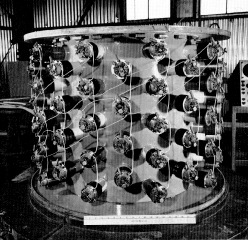 Detector of the 1953 experiment |
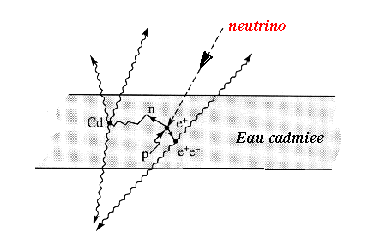 Scheme of the 1956 experiment |

 ), because,
in beta decay, he is emitted together with an electron.
Is it different from the muon type neutrino (
), because,
in beta decay, he is emitted together with an electron.
Is it different from the muon type neutrino ( ),
that could be associated to the muon, an other
particle observed in cosmic rays?...
Or is this difference only a theoretical arbitrary convenient assertion?
Reines was not permitted to continue his researches.
He had to come back at Los Alamos.
),
that could be associated to the muon, an other
particle observed in cosmic rays?...
Or is this difference only a theoretical arbitrary convenient assertion?
Reines was not permitted to continue his researches.
He had to come back at Los Alamos.
Others made the continuation and, in 1959, in the cafeteria of Columbia university,
New-York, began the quest of the  neutrino.
After a discussion between
T.D. Lee and
M. Schwartz,
this last one realized the possibility to produce a quite intense
neutrino beam from decay of pions, that are particles produced in great quantity when a proton
beam of GeV energy encounters matter.
T.D. Lee and C.N. Yang are enthusiastic about the idea and begin to calculate
the expected cross sections, while
Schwartz associates to
Leon Lederman,
Jack Steinberger
and, later, a young physicist from Orsay
Jean-Marc Gaillard.
They find the ideal detector for their experiment while looking at the spark chamber
built by J. Cronin and his team, at Princeton.
neutrino.
After a discussion between
T.D. Lee and
M. Schwartz,
this last one realized the possibility to produce a quite intense
neutrino beam from decay of pions, that are particles produced in great quantity when a proton
beam of GeV energy encounters matter.
T.D. Lee and C.N. Yang are enthusiastic about the idea and begin to calculate
the expected cross sections, while
Schwartz associates to
Leon Lederman,
Jack Steinberger
and, later, a young physicist from Orsay
Jean-Marc Gaillard.
They find the ideal detector for their experiment while looking at the spark chamber
built by J. Cronin and his team, at Princeton.
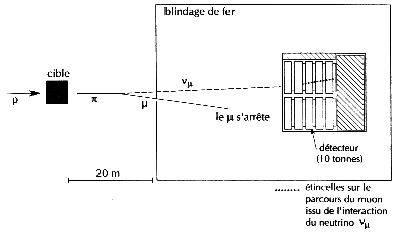
In 1960, Lee and Yang
are more and more convinced that if a reaction like
 is not observed, this is because two types of neutrinos exist.
Meantime, the construction of spark chambers (a 10 tons set full of neon gas) runs rapidly.
At the beginning of 1962, all is ready to run. The accelerator of Brookhaven delivers
some hundreds of millions of neutrinos per hour, among which about 40 interact clearly with
the detector.
In 6 cases over 40, the particle coming out of the interaction
is identified as an electron, which is approximately the expected background.
In 34 cases over 40 , the output particle is identified as a muon.
Conclusion: the
is not observed, this is because two types of neutrinos exist.
Meantime, the construction of spark chambers (a 10 tons set full of neon gas) runs rapidly.
At the beginning of 1962, all is ready to run. The accelerator of Brookhaven delivers
some hundreds of millions of neutrinos per hour, among which about 40 interact clearly with
the detector.
In 6 cases over 40, the particle coming out of the interaction
is identified as an electron, which is approximately the expected background.
In 34 cases over 40 , the output particle is identified as a muon.
Conclusion: the  is a different particle.
is a different particle.
If the  ,
and the
,
and the  have been a unique and same neutrino,
our neutrino hunters would have obtain the same numbers of muons and electrons.
have been a unique and same neutrino,
our neutrino hunters would have obtain the same numbers of muons and electrons.

 ,
and
,
and
 implied a natural fever among the physicists. Numerous experiments and
breakthroughs, almost in the same time, about quarks and leptons,
came one after an other.
implied a natural fever among the physicists. Numerous experiments and
breakthroughs, almost in the same time, about quarks and leptons,
came one after an other.
During the sixties and seventies, electrons and neutrinos of high energy
are used to probe the composition of nucleons (that is neutrons and protons).
The evidence for quarks, then the study of it, is quite grateful to the neutrino.
One sees at CERN, during the seventies, especially in 1975 and 1976, the experiments
CDHS,
CHARM and
CHARM II, then
BEBC, which all give remarkable results about quark structure of nucleons
and allow to better encompass this strange force: the weak interaction.
| BEBC | CHARM | CHARM II | CDHS |
In 1970, Glashow, Illiopoulos and Maiani make the hypothesis of the existence of a second quark family. At the end of 1974, their hypothesis is confirmed by two american experiments. Second family of neutrinos, second family of quarks: a nice bridge begins to be drawn between leptons families and quark families.
In 1973, after an incredible race between the Fermilab team and the CERN team
of the bubble chamber "Gargamelle",
neutral currents (neutrino interaction with matter where
neutrino is not transformed into an other particle like muon or electron) are
discovered.
In 1977, the team lead by Leon Lederman discovers at the Stanford accelerator
the b quark, that is a
third quarks family. Approximately at the same time,
Martin Perl discovers the particle tau, that is the third leptons family.
The  neutrino
is there: physicists can smell it but have not seen it!
In 1998, it has still not been observed experimentally!
neutrino
is there: physicists can smell it but have not seen it!
In 1998, it has still not been observed experimentally!
In 1983, the W boson
shows its existence to the experiment
UA1 by decaying in
electron and anti-neutrino. Then comes the Z boson.
The weak interaction and the neutrino print definitively their mark in physics history.
A long way has been covered since the first beta decay
recognized by Curie and Rutherford in 1898.

 can, along its travel in the universe, becomes a
can, along its travel in the universe, becomes a
 and vice-versa.
and vice-versa.
In 1979, in an other experiment, F. Reines, still near the nuclear plant of Savannah River, undertakes the measurement of the ratio between neutral current and charged current, with anti-neutrinos on deuterium. The result is not compatible with theoretical predictions and could be explained by the oscillation of neutrinos. But no conclusion yet.
Under the sting of this result (that will later be corrected by other experiments),
a team of ILL (Laue Langevin Institute)
in Grenoble try to find oscillation of neutrinos near the nuclear reactor of its
Institute. Then, many experiments search oscillation of neutrinos near nuclear plants
around the world. Especially, the team of ILL gives birth to two teams:
Goesgen in Switzerland and Bugey in France, between Chambery and Lyon.
This last one implies five french laboratories, including LAPP.
The two experiments Goesgen and Bugey
find in 1984 two opposite results: Bugey has seen oscillations and Goesgen not.
Finally, Bugey corrects the shooting direction and gives also a limit on neutrino oscillation.
No neutrinos oscillation yet.
Result: if the mass difference between
 and
and
 is not very small (more than 0.1 eV),
there is no more than 10% of mixing between the neutrinos, that is
is not very small (more than 0.1 eV),
there is no more than 10% of mixing between the neutrinos, that is
 has not more than 10% of chance to transform into a
has not more than 10% of chance to transform into a
 .
.
But the history does not stop there, because the neutrino is facetious. Since 1969, a physicist named Ray Davis tried, in Homestake mine, under 3000 meters of earth and stones, to catch a few solar neutrinos per year, using a very big detector made of 600 tons of industrial solvent based on chlorine. His first results surprised. They are confirmed today, after 20 years of data: above a neutrino energy of 1 MeV, the sun emits three times less neutrinos than predicted by the standard solar model.
Astrophysicists scraped their heads and other experiments were undertaken in order to confirm this unexpected deficit. Especially, three experiments: GALLEX, SAGE and KAMIOKANDE. The experiment of Davis, HOMESTAKE, uses chloride, GALLEX uses gallium and KAMIOKANDE uses water. Theoretically, the different experiment does not see the same neutrinos, according to their origin from thermonuclear reactions in the sun.
Could the observed deficit of solar
 neutrinos
come from neutrinos oscillation?...
The idea is attractive, but the results of the experiments show that
it is difficult to make it practical.
neutrinos
come from neutrinos oscillation?...
The idea is attractive, but the results of the experiments show that
it is difficult to make it practical.
On an other hand, in 1985, S.P. Mikheyev and A.Y. Smirnov
developped the work of L. Wolfenstein about neutrino oscillation enhanced
by the presence of matter: this is the MSW effect. The solar neutrino deficit
could come also from an oscillation during the path inside the sun.
But experiment is the only truth.

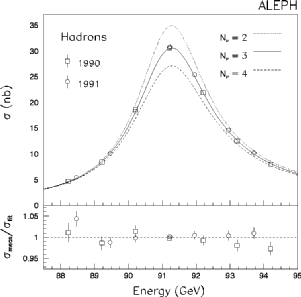
The shorter is the lifetime of a particle, the more undetermined is its mass. One says that its mass distribution has a width. And this width increases with the number of possibilities for the particle to decay. The Z boson, whose mean lifetime is around 10-23 second, can decay in pairs particle, anti-particle like neutrino, anti-neutrino. The more is the number of neutrino families, the larger is the width of the Z mass distribution.
In 1992, two experiments at CERN are built in order to detect neutrino oscillations:
NOMAD
and CHORUS,
which, thanks to neutrino oscillations, hope to see some
 neutrinos
inside a beam of
neutrinos
inside a beam of  produced with the protons of the CERN SPS accelerator.
The data taking began in 1994 and
first results were given in 1998.
produced with the protons of the CERN SPS accelerator.
The data taking began in 1994 and
first results were given in 1998.

Finally, KAMIOKANDE observes a deficit
of  in the cosmic rays showers.
To try to interpret all those deficits by using only neutrino oscillations
interpretation is not an easy
work!... And it becomes very difficult if you try to incorporate
the results obtained by LSND experiment at Los Alamos:
an oscillation between
anti-
in the cosmic rays showers.
To try to interpret all those deficits by using only neutrino oscillations
interpretation is not an easy
work!... And it becomes very difficult if you try to incorporate
the results obtained by LSND experiment at Los Alamos:
an oscillation between
anti- and anti-
and anti- .
.
In 1996, LSND experiment announced new results: 22 interactions
of anti- when 4 such interactions were expected. The non zero neutrino mass hypothesis
seems to be stronger, but the scientific quest is like a mountain climber: it must
make sure of its hanging points before continuing to progress.
Results of other experiments and confirmation from LSND
are thus impatiently waited...
when 4 such interactions were expected. The non zero neutrino mass hypothesis
seems to be stronger, but the scientific quest is like a mountain climber: it must
make sure of its hanging points before continuing to progress.
Results of other experiments and confirmation from LSND
are thus impatiently waited...
1998, the LSND confirmation arrives and a Japanese experiment, Super-Kamiokande, has seen also an anomaly in the number of atmospheric neutrinos and solar neutrinos. The results are still preliminary but all seems in place for a massive neutrino or for a new gift from nature (that is a new scientific discovery).
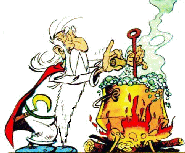
 Didier Verkindt
Didier Verkindt